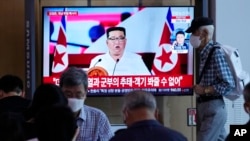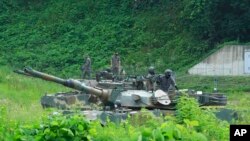Experts see a fiery speech this week by Kim Jong Un as a bid to cast an expected seventh nuclear test as a justifiable response to full-scale joint military drills by the U.S. and South Korea, which are set to resume within weeks.
In the speech Wednesday, marking the 69th anniversary of the armistice that brought the Korean War to an uneasy close, the North Korean leader said his nuclear arsenal was “fully ready” to demonstrate its power “promptly true to its mission.”
He blamed the U.S. for “instigating” South Korea and “openly waging large-scale joint war games, which gravely threaten the security of our state.” Kim said the military drills are driving North Korea-U.S. relations to “a point of fierce collision.”
The threat comes as the U.S. and South Korea have assessed that North Korea has completed its preparations for what would be a seventh nuclear test.
Military cooperation between Washington and Seoul, meanwhile, has intensified, with a resumption of joint military drills set for late August. The exercises were canceled or scaled back during the previous Moon Jae-in government to hopes of encouraging inter-Korean dialogue.
Justifying nuclear test on joint drills
Gary Samore, who served as White House coordinator for arms control and weapons of mass destruction in the Obama administration, said it was “not unusual” for North Korea to threaten to use nuclear weapons against the U.S. and South Korea.
But Kim is making new threats now “because he’s preparing for the seventh nuclear test, and he will blame the U.S. and the ROK for holding military exercises that increase tensions on the Korean Peninsula and pose a threat to North Korean security,” Samore said, using the acronym for South Korea’s official name, the Republic of Korea.
Samore said Kim was portraying Washington-Seoul military cooperation as a threat “to justify his decision to carry out a nuclear test.”
The South Korean Defense Ministry announced on July 22 that Seoul would resume full-scale exercises with the U.S. involving live field training from August 22 to September 1. The exercises will include combined air carrier strike group training and amphibious operation drills.
VOA's Korean Service asked the North Korea Mission to the U.N. in New York City for a comment on the upcoming Seoul-Washington drills but did not receive a reply.
Bruce Klingner, a senior fellow at the Heritage Foundation, said Kim criticized the resumption of joint drills “for escalating tensions and bringing the peninsula to the brink of war.” North Korea, he said, "again depicts itself as the aggrieved party rather than the violator of U.N. resolutions.”
Pyongyang conducted 18 rounds of weapons tests this year, including multiple launches of ballistic missiles in violation of U.N. resolutions.
Samore said Pyongyang’s portrayal of the nuclear test as a response to hostile acts by Washington and Seoul would also “give the Chinese and Russians an argument for not supporting any additional U.N. Security Council sanctions against North Korea.”
Warning against military expansion
In his speech, Kim also warned that his forces were prepared for “any kind of military clashes with the United States.” Naming South Korean President Yoon Suk Yeol for the first time but without using his title, Kim blamed Yoon for “aggravating military tension.”
Evans Revere, a former State Department official with extensive experience negotiating with North Korea, said Kim’s “direct attacks” on Yoon signaled his “rejection of Yoon’s North Korean initiative,” including his offer of major assistance in exchange for an end to Kim’s nuclear programs.
During his inauguration speech in May, Yoon said Seoul would offer an “audacious plan” to improve North Korea’s economy and people’s quality of life if Pyongyang began genuine denuclearization. Yoon’s office said Monday that the details of the plan were being discussed, according to South Korea’s Yonhap News.
Experts said further that Kim’s threat showed Pyongyang’s willingness to stand up to the Yoon government’s renewed alliance and military cooperation with the U.S.
Harry Kazianis, president of the Rogue States Project, said Kim’s threat showed North Korea was “willing to confront the U.S.-ROK alliance,” which may mean more nuclear and ICBM tests when the timing is right for the regime’s benefit.
Revere said, “Pyongyang needs to respond to the new ROK government’s tougher stance on South-North relations and Seoul’s reference to the ROK’s ‘kill chain strategy.’ ”
That strategy, developed a decade ago to deter North Korea’s nuclear development, involves launching preemptive strikes against Pyongyang’s missiles, key facilities and senior officials if Seoul ascertains an attack is imminent.
The South Korean Defense Ministry met with Yoon on July 6 and announced it would set up a strategic command by 2024 that directs preemptive strike strategies.
Also, under the Yoon government, the U.S. Army held live-fire drills using Apache helicopters stationed in South Korea from Monday through Friday for the first time since 2019. The training took place at the Rodriguez Live Fire Complex near the Demilitarized Zone dividing the North from the South.
And on July 5, the U.S. Air Force dispatched five F-35 stealth fighters from its Eielson Air Force Base in Alaska to South Korea and joined South Korea’s F-35s for a 10-day training, according to U.S. Forces Korea (USFK) spokesperson David Kim. The dispatch was the first publicly announced arrival of F-35s since 2017.










